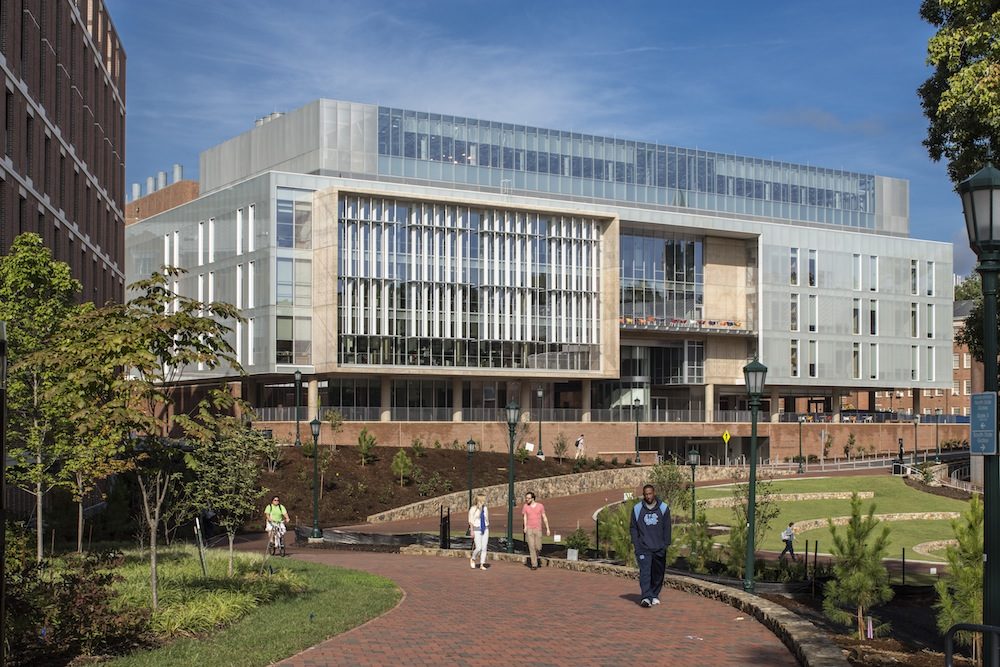
Chicago, IL: The University of North Carolina (UNC) will celebrate the opening of the new Skidmore Owings & Merrill LLP (SOM)-designed Genome Sciences Building (GSB) in Chapel Hill on Oct. 12, 2012. The building is an integral part of UNC’s Bell Tower District master plan — also designed by SOM — that strengthens connections between the academic, medical and student housing districts of the campus. The plan transformed a surface parking lot into a “crossroads” hub that includes enhanced pedestrian access, a campus green, a parking garage, a renovated campus Chiller Plant and the new GSB. The eight-story, 228,000-square-feet UNC Genome Sciences Building is designed as a center for interdisciplinary research — bringing together biologists, chemists and the medical school by creating an inviting place that facilitates the transfer of ideas and knowledge. The GSB’s brick plinth blends with UNC’s traditional Georgian architecture and emerges from the sloped site, using the natural topography to conceal lower level instruction spaces and mechanical rooms. Pedestrians can choose from multiple paths that pass under and through the new building. Landscaped and shaded areas, a ceremonial stair to the classrooms and a café make the plaza a pleasant gathering place in a central campus location. The laboratory portion of the GSB rises above the plaza with a bold concrete and glass structure that creates a distinct presence on campus. “It reflects that science is the future,” SOM Managing Partner Richard F. Tomlinson II says. “The GSB is clearly of its time’ and represents the cutting edge science that’s taking place inside.” A dramatically suspended, skylit oval stair links each of the floors and provides a sculptural highlight that enlivens the plaza while welcoming visitors to circulate. The stair symbolizes the connections of people and ideas. The design re-thinks the research lab paradigm, incorporating three distinct laboratory types — wet labs, dry labs and rooftop greenhouses. Each of the upper three floors is organized around three large wet labs wrapped in exposed concrete that receive ample natural daylighting through floor to ceiling glazing. The different orientations of the labs — north, east and west — receive different exterior fin configurations that simultaneously shield occupants from unwanted glare and solar heat gain while reflecting natural light throughout the work spaces. Between three and five principal investigators can work together in each lab, with linear benches arranged so that up to 30 people can share the same lab space. Dry labs are immediately adjacent to the wet labs, allowing researchers to work back and forth between different experiments to test results between real and simulated environments. Circulation through the building — and researcher’s private offices — is located to foster communication, dialogue and discovery among all the center’s occupants. “It is all about collaboration,” SOM Associate Director Peter Van Vechten says. “The building’s porosity and transparency provide connections; between individuals, departments, the larger campus and the natural world.” A simple, honest palette of materials is limited to concrete, metal, and high-performance glazing. The GSB maintains UNC’s longstanding commitment to sustainability, designed to achieve LEED® Silver certification. The building’s wet labs are among the first to utilize chilled beams. Natural daylighting strategies throughout contribute to an environmentally sound structure. And the GSB’s design is fully integrated with the Bell Tower site development — re-using water for irrigation and providing storm and peak water mitigation within the adjacent green space. Students, faculty and other researchers at UNC’s Genome Sciences Building are uncovering new advances every day. The building’s design communicates their efforts to the broader community while actively promoting the interdisciplinary research critical to their cutting-edge work.
About the UNC Bell Tower Master Plan The dedication of the Genome Sciences Building essentially completes the SOM-designed Bell Tower Master Plan for this vital portion of the UNC campus. “This project bridges the intellectual and campus fabric within the sciences at UNC,” SOM Director of Urban Design & Planning Douglas Voigt says. The challenging 20-acre site is home to UNC’s iconic Bell Tower and adjacent to the football stadium, but a surface parking lot and significant elevation changes created barriers to full use. The reconceived district now weaves multiple paths, student spaces and programs into a new center for campus life. “The vision was to transform an existing surface parking area into a vibrant campus crossroads, an agora’ that reflects the best qualities of the Chapel Hill campus,” Voigt says.
About Skidmore Owings & Merrill LLP Skidmore, Owings & Merrill LLP (SOM) is one of the leading architecture, interior design, engineering and urban-planning firms in the world, with a 75-year reputation for design excellence and a portfolio that includes some of the most important architectural accomplishments of the 20th and 21st centuries. Since its inception, SOM has been a leader in the research and development of specialized technologies, new processes and innovative ideas, many of which have had a palpable and lasting impact on the design profession and the physical environment. The firm’s longstanding leadership in design and building technology has been honored with more than 1,500 awards for quality, innovation, and management. The American Institute of Architects has recognized SOM twice with its highest honor, the Architecture Firm Award—in 1962 and again in 1996. The firm maintains offices in Chicago, New York, San Francisco, Los Angeles, Washington, D.C., London, Hong Kong, Shanghai, Mumbai and Abu Dhabi.